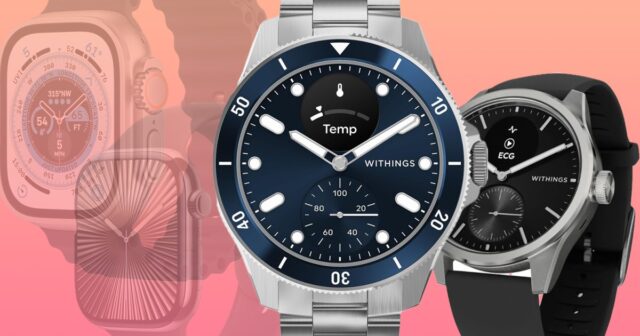I have owned both models of the Apple Watch Ultra and, before this, every model in the Apple Watch Series, starting with the very first one back in 2015. After thoroughly testing the Withings ScanWatch Nova Brilliant in recent weeks, I’ve come to a surprising conclusion: I may never purchase another Apple Watch.
Don’t get me wrong. As someone who loves exploring new gadgets and, more importantly, writes about them regularly, I am quite likely to purchase the Apple Watch Ultra 3, which is expected to be released later this year. However, today, I feel much less confident than I did yesterday that traditional smartwatches are the best choice. Instead, I’m gradually leaning toward the belief that hybrid smartwatches might be a better option for the average consumer.
Make no mistake, Apple Watches and similar products from brands like Samsung, Google, and others have revitalized the watch industry.
For centuries, watches have retained a similar design, whether we’re discussing luxury brands like Rolex and Omega or more affordable options like Swatch. While most regular timepieces have stayed analog, digital watches have also been a popular choice for decades.
The rise of smartwatches has placed multifunctional devices on our wrists, making watches more popular overall. These watches now track health, fitness, and activity metrics. They inform us by providing weather updates, calendar appointments, notifications, and messages. Additionally, they allow for music playback control, phone calls (both answering and making), voice assistant interactions, mobile payments, and much more. Along the way, we can change the faces of these watches every day, hour, or minute to suit our tastes.
Yet, all this is starting to feel like overkill, especially since it’s become crystal clear that smartwatches aren’t going to replace our phones anytime soon.
Why I loved smartwatches and then became frustrated
Some might not realize this, but the first Apple Watch was a big deal. Announced at a massive event at the Flint Center for the Performing Arts in Cupertino, California, in September 2014 alongside the iPhone 6 and iPhone 6 Plus, the watch was one of Apple’s signature “one more things.” When the Apple Watch Series 0 arrived the following spring, it included three collections: Apple Watch Sport, Apple Watch, and Apple Watch Edition, with prices ranging from $349 to $17,000 for the gold Edition models.
The first Apple Watches were quite basic, despite their crazy price points, especially when compared to later models, but they still made a significant impact, if only for their newness. Initially, Apple emphasized the watch’s fitness features. However, as new functionalities like blood oxygen saturation (SpO2), ECG/EKG monitoring, and sleep tracking were introduced, the focus shifted to the watches’ capabilities in promoting overall wellness. Along the way, it added new watch faces and, occasionally, new hardware features, like the Apple Watch Ultra’s customizable Action Button.
Over the years, I have become increasingly aware of several issues with Apple Watches that I can no longer ignore. It’s important to note that my concerns extend beyond just Apple’s wearables; I’ve also used Google’s Pixel Watches, which have similar features and frustrations. My frustration began with their consistently poor battery life, which has not improved significantly over time. For example, the Apple Watch Series models still offer only 18 hours between charges, which is half the battery life of the Apple Watch Ultra.

Additionally, I’ve noticed a growing anxiety associated with the constant need to check the Apple Watch display for time and notifications. It’s become almost habitual to glance down at my wrist multiple times an hour, feeling compelled to stay connected and informed. This incessant checking is often accompanied by an unhealthy urge to explore all the features, from tracking my workouts to monitoring my heart rate, which can sometimes feel overwhelming.
Furthermore, I can’t deny that I’ve felt the pressure of the upgrade cycle that comes around every fall when new Apple Watches are announced. The excitement in the air is palpable, yet it also brings an underlying anxiety about keeping up with the latest technology. There’s a nagging feeling that I should upgrade to the newest model to take advantage of the latest features and improvements, which adds to the overall stress of managing my device usage. It’s a constant tug-of-war between wanting to stay current and realizing that this technology can be more of a burden than a benefit.
Enter hybrids

Hybrid smartwatches have been on the market for several years, with early models like the Withings Activité and the Fossil Q Grant paving the way before the introduction of the first Apple Watch. These watches successfully blended the classic aesthetic of traditional wristwatches with modern technology, offering notification alerts and basic fitness tracking without compromising style.
For a considerable time, hybrid watches lagged behind their fully-fledged smartwatch counterparts regarding features and functionality. However, this trend shifted gradually as manufacturers started incorporating more advanced capabilities into hybrid models—many of which exceeded the offerings of popular smartwatches like the Apple Watch. Notable advancements include significantly enhanced battery life, which can stretch to weeks or even months, more discreet notification systems prioritizing usability, and a focus on essential health metrics rather than an overwhelming influx of data.
During my recent review of the Withings ScanWatch Nova Brilliant alongside my Apple Watch Ultra 2, I noticed a transformative impact on my relationship with wearable technology. The simplicity and elegance of the ScanWatch’s traditional analog display stood out, especially when compared to the often distracting array of notifications, step goals, news headlines, sports scores, and weather updates presented on the Apple Watch. Plus, the Withings watch delivers notifications more understatedly, allowing me to stay connected without feeling overwhelmed.
One of the most striking features was its impressive 30-day battery life, a significant selling point drastically altering user experience. This longevity meant I could stow away the charger in a drawer, eliminating the frequent charging rituals that often accompany conventional smartwatches. This newfound freedom minimized distraction and allowed me to appreciate the watch’s design and functionality more fully, making it a refreshing alternative in a world increasingly dominated by tech-heavy devices. As I explored the capabilities of the ScanWatch, I felt a renewed sense of balance between technology and mindfulness, finding a watch that complements my lifestyle rather than complicating it.
Everything is still there

What has surprised me the most about ditching the Apple Watch for a hybrid is that I’m not missing any vital information. Thanks to the watch’s long list of sensors and impressive Withings app, I still have access to key features provided by the Apple Watch.
The app, available for iOS and Android, tracks weight and body composition with advanced insights, including weight trends and BMI. For activity monitoring, it automatically tracks daily activity and workout sessions with details on steps, heart rate, multisport tracking, connected GPS, and fitness level assessment.
The app’s sleep analysis features provide detailed sleep metrics, including sleep cycles, sleep scores, heart rate monitoring, and snoring detection. Some versions can even detect potential sleep apnea.
For motivation, the app also includes a leaderboard feature, where friends and family can compete for weekly step counts. Thanks to in-app tracking, you don’t need Withings devices to participate—anyone with the app can join.
And because the Withings app integrates with Apple Health, all my data is stored just like it has always been on my iPhone.
Finally, the Withings app also opens up a world for other health-based products that Withings provides, including scales, blood pressure monitors, sleep trackers, and more.
What’s missing

Switching to a hybrid watch like the Withings ScanWatch Nova Brilliant from an Apple Watch involves some notable trade-offs, of course.
One of the most significant changes is the absence of a touchscreen display. Without this feature, you lose the ability to navigate a vibrant and interactive interface, which can make accessing information and features more cumbersome. For instance, you enjoy a rich visual experience with an Apple Watch, allowing seamless app interactions. At the same time, hybrid watches typically come with only the fundamental features integrated into the companion app. This means limited access to customizable watch faces, widgets, and a broader range of apps that enhance daily life.
Regarding communication, hybrid watches fall short on functionalities such as phone call handling and integration with voice assistants. While smartwatches allow you to take calls directly from your wrist and issue voice commands for tasks like sending texts or setting reminders, hybrid watches offer minimal interaction with your smartphone. This may be frustrating for users who rely heavily on these smart features for convenience and efficiency.
Moreover, features such as maps and navigation, which can be vital for outdoor activities or traveling, are either missing or poorly supported in hybrid models. Detailed workout guidance is often restricted to basic tracking capabilities, lacking the advanced metrics and real-time feedback smartwatches provide. Similarly, functionalities such as media controls and music storage are notably limited.
Another important consideration is the absence of safety features like Fall Detection, Emergency SOS, and Crash Detection. These capabilities have become essential for many users, especially those prioritizing health and safety in their wearable technology.
However, the trade-offs of choosing a hybrid watch can be worthwhile for some users. Hybrid watches often boast significantly longer battery life, lasting weeks or even months on a single charge, which, as noted, starkly contrasts the daily or every-other-day charging required by smartwatches. The traditional aesthetics of hybrid watches also appeal to those who prefer a classic look over a tech-centric design. Additionally, hybrid watches foster a less intrusive relationship with technology, allowing users to disconnect from constant notifications and digital distractions.
It’s a choice worth considering

I don’t expect to switch to a hybrid watch anytime soon, especially since I write about and review tech products. However, it’s important to recognize that 99.9% of users don’t share my viewpoint. Products like the Withings ScanWatch Nova Brilliant and the slightly larger Withings ScanWatch Nova offer significant advantages in terms of battery life and design, which many people should seriously consider. At the very least, these watches represent alternatives that could encourage more individuals to embrace smart wearables, ultimately benefiting the entire watch market.














































